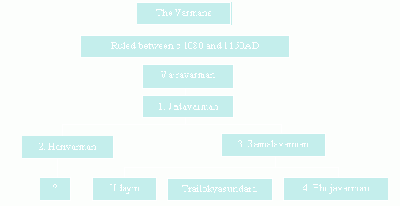Varman Dynasty
Varman Dynasty ruled in south-eastern Bengal towards the end of the 11th and first half of the 12th century AD. The history of the Varmans is known from three copperplates and the Bhuvanesvara inscription of Bhatta Bhavadeva. The Varman kings claim their descent from the Yadava dynasty ruling over Simhapura, which has been identified with modern Singapuram in Kalinga (northern Orissa) between Chicacole and Narasannapeta.
The kingdom of Simhapura in Kalinga is known to have existed as early as the 5th century AD and as late as the 12th century AD. The Varmans most probably came to Bengal in the train of Kalachuri Karna's invasion of vanga. Karna seems to have invaded southeastern Bengal from Orissa, probably following the same route as Rajendra Chola's army. It is quite likely that the Varmans accompanied Karna, stayed in Bengal, and at an opportune moment carved out an independent kingdom for themselves.

The account of Jatavarman's military conquests, as given in the Belava plate of Bhojavarman, leaves little doubt that he was responsible for the foundation of the rule of his dynasty. Vajravarman, father of Jatavarman, is only eulogised as a brave warrior, a poet and a scholar. The reference to Jatavarman's marriage with Virashri, daughter of Karna, and to Divya, who wrested northern Bengal from the Palas, help us in fixing the date of Jatavarman's rise to power sometime in between 1050 and 1075 AD. Jatavarman's marriage with Karna's daughter was significant and was perhaps a great factor in the rise of the political fortunes of the Varman family. Karna's attack on Vanga must have dealt the last blow to the Chandra empire and the Varmans captured power soon after from govindachandra or his successor. Jatavarman must have risen to independence simultaneously or just before Divya, against whom he is mentioned to have waged wars.
Jatavarman's assault on anga, as mentioned in the Belava plate, must have involved him in a struggle with the Pala ruler ramapala. The unsettled condition of the Pala empire during the early years of Ramapala may have tempted Jatavarman to measure swords with the Palas also. His other two adversaries, Govardhana and the king of kamarupa, cannot be identified. It is also a problem to determine his successor. But it is assumed on good grounds that Harivarman succeeded him and was followed by his brother Samalavarman. Harivarmadeva, under whom Bhatta Bhavadeva of the Bhuvanesvara Prashasti served as the minister of war and peace, was possibly the same as Harivarman of the Varman dynasty. Two Buddhist manuscripts, copied respectively in the 19th and the 39th regnal years, preserve the name of Harivarman and on the basis of the colophon of the second manuscript it can be assumed that Harivarman had a long reign of 46 years. It conforms to the information of the Bhuvanesvara inscription, where it is recorded that he ruled for a long time.
Harivaman, having seen Ramapala's success in recovering northern Bengal, propitiated Ramapala in order to avoid a Pala attack on his territory. It is doubtful whether Harivarman extended his rule towards Orissa. There is reference to a son of Harivarman both in the Bhuvanesvara inscription and Vajrayogini plate, but hardly anything is known about him.
Samalavarman, another son of Jatavarman, was the next king. His name figures prominently in the genealogical accounts of the Vaidik Brahmins, who are said to have migrated to Bengal from madhyadesha during his reign. There was matrimonial connection between the Varmans and the Sri Lankan king Vijayabahu I; in all probability Trailokyasundari, daughter of Samalavarman, was married to the Lankan king.
Bhojavarman, son of Samalavarman, was the last known king of the dynasty and the Belava plate was issued in his fifth regnal year from the jayaskandhavara situated at vikramapura. The Varman rulers were Vaisnavas, but they also seem to have patronised Buddhism. Samalavarman's Vajrayogini plate was issued to grant land either to a temple of Prajnaparamita or to a Buddhist devotee named Bhimadeva as a reward for his reading the Prajnaparamita.
Four Varman kings of southeastern Bengal are known to have ruled for about 60/70 years. The Senas ousted them during or shortly after the reign of Bhojavarman. [AM Chowdhury]
